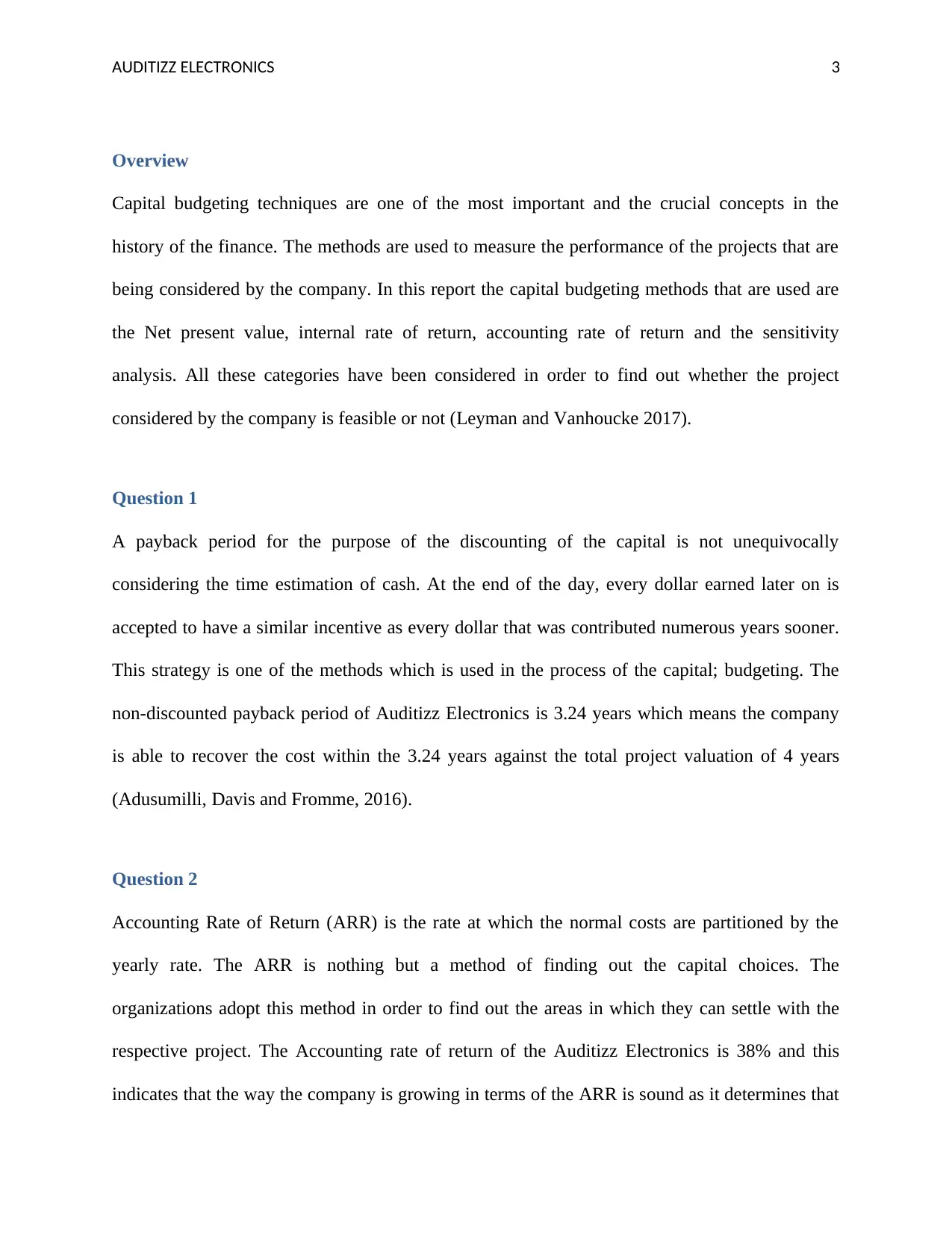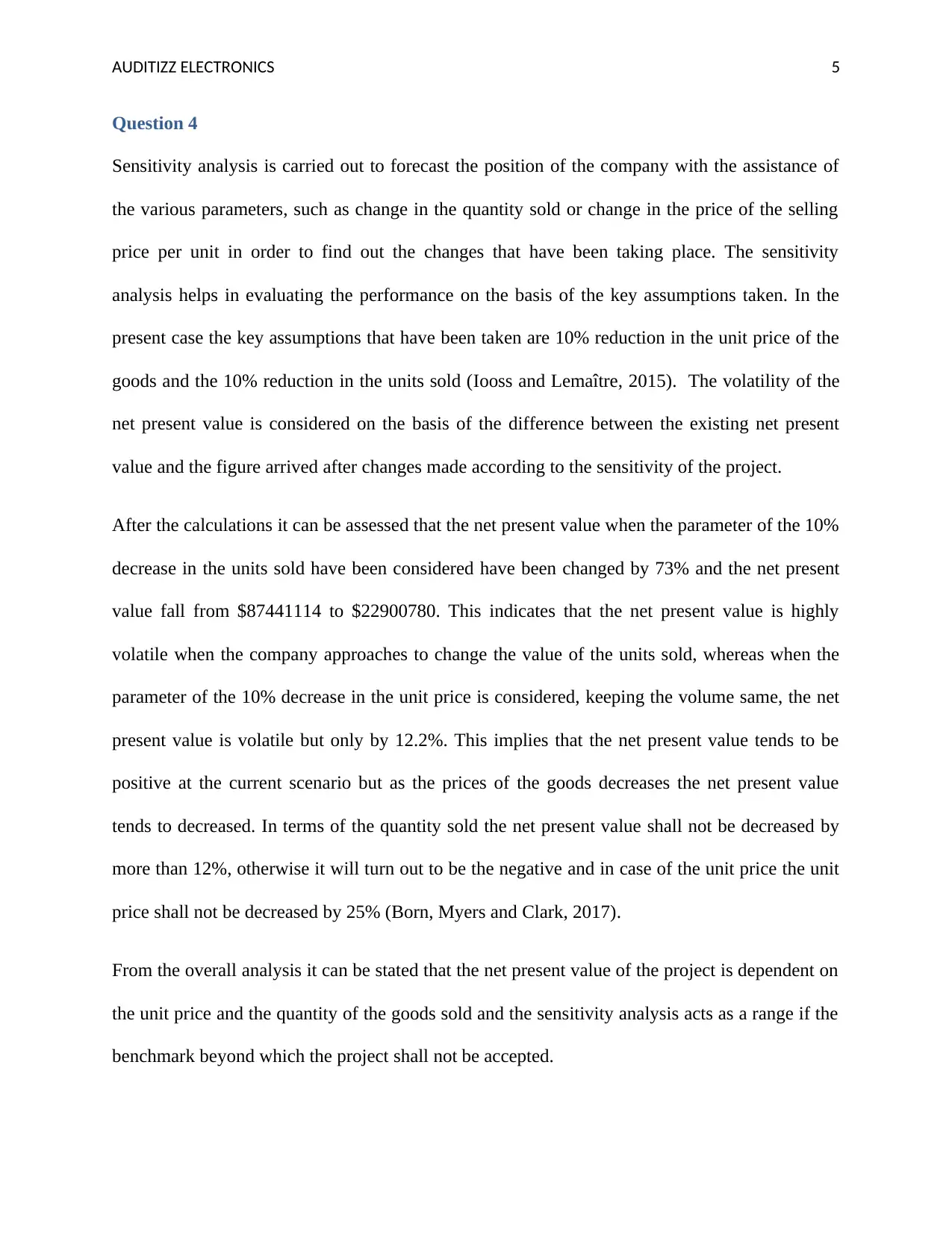Capital Budgeting Techniques for Auditizz Electronics
VerifiedAdded on 2023/04/03
|8
|1382
|496
AI Summary
This report discusses the capital budgeting techniques used by Auditizz Electronics to evaluate the feasibility of a project. It covers the payback period, accounting rate of return, net present value, internal rate of return, and sensitivity analysis. The report concludes that the project is feasible based on positive net present value and high internal rate of return.
Contribute Materials
Your contribution can guide someone’s learning journey. Share your
documents today.

Running Head: AUDITIZZ ELECTRONICS 1
AUDITIZZ ELECTRONICS
AUDITIZZ ELECTRONICS
Secure Best Marks with AI Grader
Need help grading? Try our AI Grader for instant feedback on your assignments.

AUDITIZZ ELECTRONICS 2
Table of Contents
Overview.....................................................................................................................................................3
Question 1...................................................................................................................................................3
Question 2...................................................................................................................................................3
Question 3...................................................................................................................................................4
Question 4...................................................................................................................................................5
Question 5...................................................................................................................................................6
Question 6...................................................................................................................................................6
Question 7...................................................................................................................................................7
References...................................................................................................................................................8
Table of Contents
Overview.....................................................................................................................................................3
Question 1...................................................................................................................................................3
Question 2...................................................................................................................................................3
Question 3...................................................................................................................................................4
Question 4...................................................................................................................................................5
Question 5...................................................................................................................................................6
Question 6...................................................................................................................................................6
Question 7...................................................................................................................................................7
References...................................................................................................................................................8

AUDITIZZ ELECTRONICS 3
Overview
Capital budgeting techniques are one of the most important and the crucial concepts in the
history of the finance. The methods are used to measure the performance of the projects that are
being considered by the company. In this report the capital budgeting methods that are used are
the Net present value, internal rate of return, accounting rate of return and the sensitivity
analysis. All these categories have been considered in order to find out whether the project
considered by the company is feasible or not (Leyman and Vanhoucke 2017).
Question 1
A payback period for the purpose of the discounting of the capital is not unequivocally
considering the time estimation of cash. At the end of the day, every dollar earned later on is
accepted to have a similar incentive as every dollar that was contributed numerous years sooner.
This strategy is one of the methods which is used in the process of the capital; budgeting. The
non-discounted payback period of Auditizz Electronics is 3.24 years which means the company
is able to recover the cost within the 3.24 years against the total project valuation of 4 years
(Adusumilli, Davis and Fromme, 2016).
Question 2
Accounting Rate of Return (ARR) is the rate at which the normal costs are partitioned by the
yearly rate. The ARR is nothing but a method of finding out the capital choices. The
organizations adopt this method in order to find out the areas in which they can settle with the
respective project. The Accounting rate of return of the Auditizz Electronics is 38% and this
indicates that the way the company is growing in terms of the ARR is sound as it determines that
Overview
Capital budgeting techniques are one of the most important and the crucial concepts in the
history of the finance. The methods are used to measure the performance of the projects that are
being considered by the company. In this report the capital budgeting methods that are used are
the Net present value, internal rate of return, accounting rate of return and the sensitivity
analysis. All these categories have been considered in order to find out whether the project
considered by the company is feasible or not (Leyman and Vanhoucke 2017).
Question 1
A payback period for the purpose of the discounting of the capital is not unequivocally
considering the time estimation of cash. At the end of the day, every dollar earned later on is
accepted to have a similar incentive as every dollar that was contributed numerous years sooner.
This strategy is one of the methods which is used in the process of the capital; budgeting. The
non-discounted payback period of Auditizz Electronics is 3.24 years which means the company
is able to recover the cost within the 3.24 years against the total project valuation of 4 years
(Adusumilli, Davis and Fromme, 2016).
Question 2
Accounting Rate of Return (ARR) is the rate at which the normal costs are partitioned by the
yearly rate. The ARR is nothing but a method of finding out the capital choices. The
organizations adopt this method in order to find out the areas in which they can settle with the
respective project. The Accounting rate of return of the Auditizz Electronics is 38% and this
indicates that the way the company is growing in terms of the ARR is sound as it determines that

AUDITIZZ ELECTRONICS 4
the project is expected to earn 28% of the cents for the every dollar invested by the company
(Christodoulou, Clubb and Mcleay, 2016).
Question 3
The net present value and the internal rate of return of Auditizz Electronics are presented in the
table below.
Net Present value Rate of Return
@11%
Net Present
value
0 -103500000 1.0000 -103500000
1 43245000 0.9009 38959459
2 43833840 0.8116 35576528
3 69016656 0.7312 50464384
4 100102690 0.6587 65940743
Net Present Value 87441114
IRR Annual Cash Flows
0 -103500000
1 43245000
2 43833840
3 69016656
4 100102690
IRR 40.53%
The net present value of the Auditizz Electronics is positive at $87441114, whereas the internal
rate of return is the return at which the present value of the cash flow is equivalent to zero and it
is one of the most widely sued metric while applying the capital budgeting techniques
(Borgonovo and Plischke, 2016).
the project is expected to earn 28% of the cents for the every dollar invested by the company
(Christodoulou, Clubb and Mcleay, 2016).
Question 3
The net present value and the internal rate of return of Auditizz Electronics are presented in the
table below.
Net Present value Rate of Return
@11%
Net Present
value
0 -103500000 1.0000 -103500000
1 43245000 0.9009 38959459
2 43833840 0.8116 35576528
3 69016656 0.7312 50464384
4 100102690 0.6587 65940743
Net Present Value 87441114
IRR Annual Cash Flows
0 -103500000
1 43245000
2 43833840
3 69016656
4 100102690
IRR 40.53%
The net present value of the Auditizz Electronics is positive at $87441114, whereas the internal
rate of return is the return at which the present value of the cash flow is equivalent to zero and it
is one of the most widely sued metric while applying the capital budgeting techniques
(Borgonovo and Plischke, 2016).
Secure Best Marks with AI Grader
Need help grading? Try our AI Grader for instant feedback on your assignments.

AUDITIZZ ELECTRONICS 5
Question 4
Sensitivity analysis is carried out to forecast the position of the company with the assistance of
the various parameters, such as change in the quantity sold or change in the price of the selling
price per unit in order to find out the changes that have been taking place. The sensitivity
analysis helps in evaluating the performance on the basis of the key assumptions taken. In the
present case the key assumptions that have been taken are 10% reduction in the unit price of the
goods and the 10% reduction in the units sold (Iooss and Lemaître, 2015). The volatility of the
net present value is considered on the basis of the difference between the existing net present
value and the figure arrived after changes made according to the sensitivity of the project.
After the calculations it can be assessed that the net present value when the parameter of the 10%
decrease in the units sold have been considered have been changed by 73% and the net present
value fall from $87441114 to $22900780. This indicates that the net present value is highly
volatile when the company approaches to change the value of the units sold, whereas when the
parameter of the 10% decrease in the unit price is considered, keeping the volume same, the net
present value is volatile but only by 12.2%. This implies that the net present value tends to be
positive at the current scenario but as the prices of the goods decreases the net present value
tends to decreased. In terms of the quantity sold the net present value shall not be decreased by
more than 12%, otherwise it will turn out to be the negative and in case of the unit price the unit
price shall not be decreased by 25% (Born, Myers and Clark, 2017).
From the overall analysis it can be stated that the net present value of the project is dependent on
the unit price and the quantity of the goods sold and the sensitivity analysis acts as a range if the
benchmark beyond which the project shall not be accepted.
Question 4
Sensitivity analysis is carried out to forecast the position of the company with the assistance of
the various parameters, such as change in the quantity sold or change in the price of the selling
price per unit in order to find out the changes that have been taking place. The sensitivity
analysis helps in evaluating the performance on the basis of the key assumptions taken. In the
present case the key assumptions that have been taken are 10% reduction in the unit price of the
goods and the 10% reduction in the units sold (Iooss and Lemaître, 2015). The volatility of the
net present value is considered on the basis of the difference between the existing net present
value and the figure arrived after changes made according to the sensitivity of the project.
After the calculations it can be assessed that the net present value when the parameter of the 10%
decrease in the units sold have been considered have been changed by 73% and the net present
value fall from $87441114 to $22900780. This indicates that the net present value is highly
volatile when the company approaches to change the value of the units sold, whereas when the
parameter of the 10% decrease in the unit price is considered, keeping the volume same, the net
present value is volatile but only by 12.2%. This implies that the net present value tends to be
positive at the current scenario but as the prices of the goods decreases the net present value
tends to decreased. In terms of the quantity sold the net present value shall not be decreased by
more than 12%, otherwise it will turn out to be the negative and in case of the unit price the unit
price shall not be decreased by 25% (Born, Myers and Clark, 2017).
From the overall analysis it can be stated that the net present value of the project is dependent on
the unit price and the quantity of the goods sold and the sensitivity analysis acts as a range if the
benchmark beyond which the project shall not be accepted.

AUDITIZZ ELECTRONICS 6
Question 5
From the above scenario it can be stated that the project can be accepted as the net present value
of the project is positive at $87441114, the company is able to recover the costs within the 3.24
years which is on margin but, but recovering the cost before the stipulated time period is still
better. The IRR on other hand is 40.53% which is again the criteria and to decide whether the
project is feasible or not and in this particular case the project is feasible as it will provide the
higher returns and the returns are greater than the cost of capital involved. The Accounting return
is again the concept that has been used for the same purpose and the results show that the ARR is
38% which will provide more benefits and opportunities to the company (Sim and Wright,
2017).
Question 6
The Efficient Market Hypothesis, or EMH, is a term in the financial theory used to state the price
of the asset with the fully reflecting information. A direct meaning of the concept is that it has
the ability to beat the market prices on the basis of the risk adjusted factors. This term was
basically originated in the year 1960. As per the EMH, the value of the project considered by the
Auditizz Electronics is majorly focusing on stock trades, making it inconceivable for investors to
either buy undervalued stocks or sell stocks at swelled costs. Also in this scenario the net present
value of market indicates truly that it’s expected to give the return greater than what the market
requires and the same can be seen from the calculations as well (Ţiţan, 2015).
Question 7
The positive NPV will induce the market value of the corporation and the more investors will
tend to invest in the market. The company like Auditizz Electronics will have the benefit of the
Question 5
From the above scenario it can be stated that the project can be accepted as the net present value
of the project is positive at $87441114, the company is able to recover the costs within the 3.24
years which is on margin but, but recovering the cost before the stipulated time period is still
better. The IRR on other hand is 40.53% which is again the criteria and to decide whether the
project is feasible or not and in this particular case the project is feasible as it will provide the
higher returns and the returns are greater than the cost of capital involved. The Accounting return
is again the concept that has been used for the same purpose and the results show that the ARR is
38% which will provide more benefits and opportunities to the company (Sim and Wright,
2017).
Question 6
The Efficient Market Hypothesis, or EMH, is a term in the financial theory used to state the price
of the asset with the fully reflecting information. A direct meaning of the concept is that it has
the ability to beat the market prices on the basis of the risk adjusted factors. This term was
basically originated in the year 1960. As per the EMH, the value of the project considered by the
Auditizz Electronics is majorly focusing on stock trades, making it inconceivable for investors to
either buy undervalued stocks or sell stocks at swelled costs. Also in this scenario the net present
value of market indicates truly that it’s expected to give the return greater than what the market
requires and the same can be seen from the calculations as well (Ţiţan, 2015).
Question 7
The positive NPV will induce the market value of the corporation and the more investors will
tend to invest in the market. The company like Auditizz Electronics will have the benefit of the

AUDITIZZ ELECTRONICS 7
enhanced positive net present value. The market value is also subjected to the several other
factors and therefore the positive net present value will indicate the higher market value of the
corporation and vice versa (Christodoulou, Clubb and Mcleay, 2016).
enhanced positive net present value. The market value is also subjected to the several other
factors and therefore the positive net present value will indicate the higher market value of the
corporation and vice versa (Christodoulou, Clubb and Mcleay, 2016).
Paraphrase This Document
Need a fresh take? Get an instant paraphrase of this document with our AI Paraphraser

AUDITIZZ ELECTRONICS 8
References
Adusumilli, N., Davis, S. and Fromme, D., 2016. Economic evaluation of using surge valves in
furrow irrigation of row crops in Louisiana: A net present value approach. Agricultural Water
Management, 174, pp.61-65.
Borgonovo, E. and Plischke, E., 2016. Sensitivity analysis: a review of recent
advances. European Journal of Operational Research, 248(3), pp.869-887.
Born, J.A., Myers, D.H. and Clark, W.J., 2017. Trump tweets and the efficient Market
Hypothesis. Algorithmic Finance, 6(3-4), pp.103-109.
Christodoulou, D., Clubb, C. and Mcleay, S., 2016. A structural accounting framework for
estimating the expected rate of return on equity. Abacus, 52(1), pp.176-210.
Iooss, B. and Lemaître, P., 2015. A review on global sensitivity analysis methods. In Uncertainty
management in simulation-optimization of complex systems (pp. 101-122). Springer, Boston,
MA.
Leyman, P. and Vanhoucke, M., 2017. Capital-and resource-constrained project scheduling with
net present value optimization. European Journal of Operational Research, 256(3), pp.757-776.
Sim, T. and Wright, R.H., 2017. Stock valuation using the dividend discount model: An internal
rate of return Approach. In Growing Presence of Real Options in Global Financial Markets (pp.
19-32). Emerald Publishing Limited.
Ţiţan, A.G., 2015. The efficient market hypothesis: Review of specialized literature and
empirical research. Procedia Economics and Finance, 32, pp.442-449.
References
Adusumilli, N., Davis, S. and Fromme, D., 2016. Economic evaluation of using surge valves in
furrow irrigation of row crops in Louisiana: A net present value approach. Agricultural Water
Management, 174, pp.61-65.
Borgonovo, E. and Plischke, E., 2016. Sensitivity analysis: a review of recent
advances. European Journal of Operational Research, 248(3), pp.869-887.
Born, J.A., Myers, D.H. and Clark, W.J., 2017. Trump tweets and the efficient Market
Hypothesis. Algorithmic Finance, 6(3-4), pp.103-109.
Christodoulou, D., Clubb, C. and Mcleay, S., 2016. A structural accounting framework for
estimating the expected rate of return on equity. Abacus, 52(1), pp.176-210.
Iooss, B. and Lemaître, P., 2015. A review on global sensitivity analysis methods. In Uncertainty
management in simulation-optimization of complex systems (pp. 101-122). Springer, Boston,
MA.
Leyman, P. and Vanhoucke, M., 2017. Capital-and resource-constrained project scheduling with
net present value optimization. European Journal of Operational Research, 256(3), pp.757-776.
Sim, T. and Wright, R.H., 2017. Stock valuation using the dividend discount model: An internal
rate of return Approach. In Growing Presence of Real Options in Global Financial Markets (pp.
19-32). Emerald Publishing Limited.
Ţiţan, A.G., 2015. The efficient market hypothesis: Review of specialized literature and
empirical research. Procedia Economics and Finance, 32, pp.442-449.
1 out of 8
Related Documents
Your All-in-One AI-Powered Toolkit for Academic Success.
+13062052269
info@desklib.com
Available 24*7 on WhatsApp / Email
![[object Object]](/_next/static/media/star-bottom.7253800d.svg)
Unlock your academic potential
© 2024 | Zucol Services PVT LTD | All rights reserved.



![AUDITIZZ ELECTRONICS REPORT ON BUSINESS FINANCE [Enter YOUR name here]](/_next/image/?url=https%3A%2F%2Fdesklib.com%2Fmedia%2Fimages%2Fps%2Ff8b2265e530d4c6e9e0b7871ef3f5175.jpg&w=256&q=75)
